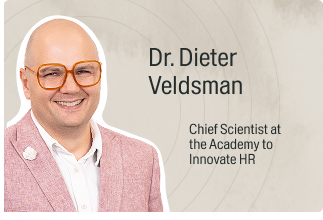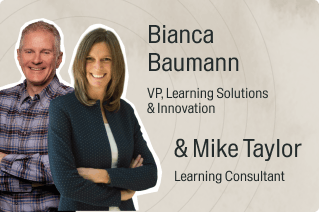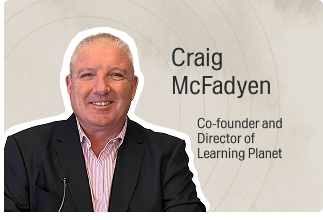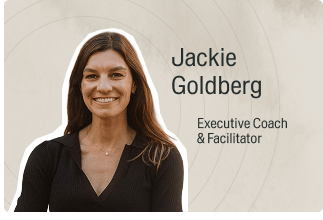Stronger Together: The Intersection of L&D and Enablement with Devon McDermott, Enablement Leader
About the guest
Devon wants to live in a world where enablement isn't a mystery and every initiative drives real business impact.
With 12+ years of experience across training, L&D, and enablement, she's build and led enablement functions and teams at companies like Salesforce, Sprinklr, Salithru, Persado and Dandy.
She's the co-host of Troubleshooting Enablement, where she chats with brilliant enablers from around the world to decode what actually works.
While she's not deep in enablement strategy, she's honing her voice-over skills, bingeing Golden Girls (and planning her future podcast about it), swapping skincare tips, hiking in Joshua Tree, and admiring the mid-century gems of Palm Springs, always with SPF 50 in hand.
Julia: Welcome to L&D in 20, your go-to resource for all things workplace learning, brought to you by Go1. I'm your host, Julia Nieradka, Manager of Customer Success at Go1.
Today on the show, I'm very excited to be joined by Devon McDermott, enablement leader with 12 years of experience across training L&D and enablement. She's built and led enablement functions and teams at companies like Salesforce, Sprinklr, Salithru and Persado before heading up GTM Enablement at Dandy.
Devon, welcome to the show.
Devon: Thank you so much for having me. I'm so excited to be here.
Julia: We are so excited to have you. In today's deep dive segment, we're going to discuss the intersection of L&D and enablement, which is pretty perfect for you. So, Devon, you've been in enablement for a long time. I know you're a proponent of leaning into the L&D side of enablement. Can you tell us about how you see the partnership between enablement and L&D?
Devon: Absolutely. So enablement is stronger when it's deeply connected to L&D and in practice, L&D and enablement are so closely connected, but ultimately they support the business at very different altitudes and with different areas of focus and scope. So L&D is typically going to focus on building top line knowledge and skills via training. Things like communication, leadership and feedback things like that, through more company-wide programs like orientation or leadership development, the types of programs that are usually aligned to those broader skill gaps or overarching cultural initiatives.
Enablement is going build on that foundation, then some. Uh, so we're really focused on role specific highly contextual programs designed to ensure that those skills are actually applied effectively in role and on the job enablement. Typically, we focus on customer facing teams, but we also focus on the environment. We focus on behaviour change tools and processes that actually drive measurable outcomes.
When I think about enablement, it's not a program, it's not a function.
Enablement is, is actually an ecosystem that's designed to drive impact and effectiveness. So not just through training or learning efforts, which are incredibly important, um, but enablement. We often try to distance ourselves from just being relegated to a training function, but rather we focus on how that training and those other factors that I mentioned actually translate to daily execution and revenue or business impact.
And the strongest partnerships that I've seen are where L&D sets the what, and Enablement is driving the how.
So for example, L&D might establish a feedback methodology and a coaching model, and then run that core foundational feedback or coaching training. Enablement can then take that, pull it into context, into their programming, and layer in what this looks like in practice during, during things like pipeline reviews, customer conversations, or even strategic deal planning.
I'd say like in a perfect world, uh, it's a symbiotic relationship where L&D owns that learning approach and high level strategy and enablement owns our team specific strategy, which is again, typically empowering our customer facing teams with the resources and tools they need to be successful.
And when the two are working together in lockstep, really have the power to create that full ecosystem where skills, behaviors, and performance are actually supporting and reinforcing each other, and then we can build the full organizational flywheel for how we drive continuous business impact.
Julia: That's such a clear distinction. I love the what versus how analogy, and I think that really frames everything so powerfully. Can you share an example, maybe Devon, of when that what versus how dynamic really clicked internally for a project that you were maybe a part of?
Devon: Yeah, so it's one example that I'm thinking about is when an L&D group that I worked with rolled out a company-wide coaching model as part of their like leadership development initiative. So this was a, a pretty solid program. The what was clear, but if we were to leave it at that, it would've stayed fairly abstract for our sales managers, right?
So it's like hypothetical, how do you be a great leader? What does it look like to run a great one-on-one? Nothing really contextual. Um, not like how do I actually go and do this on the job when I wrap up this training? So enablement was thankfully part of this project. We partnered with L&D to bring this to life for our teams and made sure that everything we were focusing on, um, was aligned to how folks work.
So. What I did was I built in, uh, live deal reviews and pipeline coaching sessions, along with very simple best practice guides and coaching guides, and it allowed me to actually embed the model that our L&D team was empowering the full organization with directly into how our managers coach their teams.
So what we were able to do is take the kind of the concept of what L&D was sharing around the theory. Place it into practice for the teams that we support. Um, adoption and performance improved because of how this was reinforced and shared with our managers. The big, the big focus for me is really like, how do we thread this into the flow of work for our teams so it's actionable and something that they can take and run with. Um, the other thing that we did was we threaded conversational intelligence via one of our tools that we use to allow managers to take their coaching experience even further and allow them to really engage in very targeted coaching conversations with their team. So again. threading theory into practice and using our tech stack to really bring it to life.
So when the what and how really clicked when we were able to bring those two worlds together and move from macro to micro for the teams that we support. And that enablement, uh, contextualization of the theory allowed us to make that part of our manager's environment.
Julia: Those are some fantastic results. Thank you for sharing that, Devon. what opportunities do you think are missed when L&D and enablement are not aligned?
Devon: This is a big one. When I think about the key differences with L&D and enablement, I think it's important to acknowledge in the context of your question. So, when it comes to scope, L&D is about learning, enablement is about performance. When it comes to focus, and what each group is leaning into, L&D is focusing on skill building while enablement is ensuring those skills translate to those business outcomes. And when we think about measurement, L&D is typically measured by your learning progress, and enablement is going to be measured by impact on productivity and results.
The problem is, when these functions operate in silos, we end up with learning experiences that feel pretty disconnected from the actual job, and we get frustrated because they don't actually result in the outcomes we're trying to achieve.
So, enablement is going to move really fast and build content. Content that might lack learning science and L&D is going to come in and build programs that don't always connect to behavior or business outcomes. When the two teams come together and they align together on strategy and execution, they can actually strengthen each other and in turn the outcomes that you're going to see.
From each of those programs. Enablement can gain depth through your L&D team's experience in things like instructional design and adult learning. And L&D is going to gain relevance and proximity to the business by adopting enablement's performance lens. So again, building empathy for each other and really understanding how each of their functions and programs are interconnected.
We're also seeing the line start to blur in the best ways possible.
In a number of the companies I've worked with, ID, so instructional designers and learning experience designers are actually now embedded within the enablement team and aligned to specific functions in the organization. Those folks will often share a process flow with similar roles on the L&D team.
So again, like the more alignment and interconnectedness between the two groups is only going yield better results. Both of these teams are here to help people do better work and deliver results. And when we align on strategy, execution, and measurement, we can actually create programs that are connected, contextual, and designed to, uh, drive learning that sticks so that we can see the results that, that both of us set out to achieve.
Julia: And that alignment is so important. And I think from what you mentioned, that the fragmentation really resonates and I'm sure it's going to resonate with a lot of the listeners. Um, it's such a common, common friction point in many organizations, but I think it's, it's especially probably the most, uh, common in larger organizations. If you were to give one quick piece of advice for somebody who's experiencing that right now, what is one sort of low lift piece of advice that they could take away from this to start bridging the.
Devon: Communication is key. Start with a conversation. Reach out to your counterpart in L&D or in enablement depending on your role, and ask a very simple question, what are you working on right now that overlaps with my audience or goals? The follow up question is how can we partner on that? That one step opens the door to visibility and shared context.
From there, you can identify maybe it's one specific program or a part of a program like onboarding or leadership development or whatever you're working on, and explore how you might align your approach, messaging frameworks, uh, or reinforcement. Talk through challenges. That you've had with previous projects where you weren't aligned.
And really, again, find places where collaboration is actually going to create momentum. You don't need to reorg your business or even have a shared tech stack to make progress. You just need to start mapping the overlaps and building momentum from successful engagements.
Julia: What are some common blockers to creating alignment internally?
Devon: One of the biggest blockers to alignment between L&D and enablement is organizational silos.
The second is the lack of, or just poor organization-wide planning. I think those things are the two biggest challenges for true alignment. Decentralized reporting structure is one thing. That's fine. Siloed execution is a whole other issue, and I feel like this happens a lot in companies that are either growing really fast or operating with misaligned processes where teams are so focused on speed, delivery and execution rather than a shared strategy or even like a systems led approach.
Um, I've been in a situation where L&D was working on a leadership development program because it was part of their OKRs. And enablement was simultaneously running a manager coaching initiative and building a sales manager operating rhythm and, and, you know, ways of working for the sales leadership team.
But there was zero alignment between the two programs. Both teams were trying to solve for the same layer of the organization, right? We wanted to make our managers more effective, but because we were doing it in parallel and not in partnership, we created a ton of duplicative efforts. Confusion for the folks on the ground receiving the training and enablement experiences from both of us.
And a truly missed opportunity to scale something that would have a really great impact. Um, and most importantly, I think the biggest, uh, negative outcome of this lack of alignment, uh, was confusion and frustration from our end users. It's something you never want because both teams lose credibility and lose focus.
Our managers felt like we were pulling them into, you know, the same trainings a million times, and it was really not a positive experience. I think another common blocker is the us versus them mindset. So when L&D and enablement see themselves as fundamentally different or supporting different parts of the business, it does become a lot harder to collaborate across those two systems and silos don't allow for integration.
But I do want to acknowledge that even the, the right org structure and planning structure, uh, it's not just going to organically create terrific alignment, right? It doesn't happen by accident. So it does take deliberate shared planning, really tight communication and a commitment on from both teams to co-own outcomes rather than kind of running in their own direction based on their org charts and doing their own thing.
Julia: So running in their own direction, um, and connected in some way. And I guess, creating that and or rather not creating that can be really frustrating for the learner at the end. Of the day. So I love that call out. Thank you. Are there any tactics and strategies that L&D leaders should be considering?
Devon: The first thing is to align early, right? Sit down with enablement during goal planning, not afterwards, identify those areas where priorities might overlap and co-create programs that are going to reinforce each other instead of running in parallel.
As we talked about earlier, the, the biggest, uh, challenge when teams are in, let's say, uh, annual or quarterly planning is teams will sit down, build their entire strategy and not account for all of the other groups that might be able to support them. Bring enablement in early, the earlier the better, and allow them to be part of that planning process with you.
The second piece for L&D is to, uh, translate what they're doing for the field. So, as we talked about earlier, L&D is going to set the foundation, but enablement typically brings that foundation to life in, in the role for the teams that they support. When L&D and enablement partner early, they can partner on how learning is actually going to be applied through various on the job methods like coaching, workflows, and daily execution.
It gives L&D that exposure to, um, the environment. The teams they're supporting work within, while they're not building that programming, it's important to have that context to make sure that what they're doing is going to be effective and actually, uh, and actually stick. The, the third thing is to use shared frameworks to create consistency across leadership, onboarding, and development.
The third thing is to, uh, focus on using shared frameworks which allow you to create consistency across your various programs like leadership, onboarding, and development programs. So when I say frameworks, I mean, you know, what is your leadership approach that you're taking? What is your onboarding framework, but also how you're going about scoping and building your program.
So leaning into things like performance consulting, behavior engineering model, maybe 70, 20, 10 for the how and the where you deliver learning, but really making sure that the way that you're showing up across the business is aligned across your teams.
The fourth thing is to reinforce consistently learning should not stop at completion, and we know that it doesn't.
Real adoption and mastery takes time, and as I mentioned earlier, L&D functions will typically focus on adoption of programs, completion of training, completion of certification. That's just the beginning. So for L&D to really lean into building nudges, micro learning, behavioral checkpoints in partnership with enablement to make sure that we are supporting the adoption application and mastery of whatever topic we're focusing on over time.
Finally, the, the biggest thing here is to stay connected. So strong relationships between L&D and enablement are going to make the work more strategic, more relevant, easier to scale, and most importantly, easier to track and iterate on over time.
Julia: Fantastic advice for our listeners. Thank you so much, Devon.
Now let's kick into our next segment, AI at Work, where we dive into how you're using AI to work smarter and how you're helping your teams to do the same.
So Devon, how are you thinking about leveraging AI at work and in your role as well as in L&D?
Devon: The big thing with AI in L&D and enablement is that it is fundamentally altering the learning landscape. Uh, folks who learn how to integrate AI into their workflows and decision making are going to lead that next wave of innovation.
And so for folks listening, if you haven't started exploring AI yet, now is the time. This is your call to action. L&D really can't afford to stay in the lane of traditional learning teams using AI tools here and there, or testing things out.
We really need to evolve into strategic AI L&D operators, uh, to stay ahead of the curve and it's not as difficult, I think, as so many of us think. So a quick little story. A few years ago, I used to host a monthly Enablement news podcast, and I still remember in 2022 talking about how AI was going to be so wild.
Imagine what it can do in the next 10 to 15 years. Fast forward to just a few short years later, and its everywhere. We massively underestimated the speed and impact of the shift, and now embedded in nearly every single tool and every single workflow that we touch.
So we were again started by like dabbling in AI to see what we could do, and now we use AI in a, a very structured way in our programs and we've built GPT to do a number of things. I have a GPT that guides my team through performance consulting when scoping their programs so that we can actually scope learning needs more accurately before we go and start solutioning.
Um, we have a GPT to build role play scenarios that are realistic and aligned to business context for our teams. We use it to draft assessments, quizzes, reinforcement modules, um, write our newsletters for us and build custom comms for the teams that we support. Um, we also have custom GPTs to help us write better prompts for better outputs.
Because prompt engineering and prompting is incredibly challenging and it's one of the most important skills to get great outputs from, uh, from AI. The other thing we have a custom GPT for is identifying the most relevant KPIs to track for our programs, and then use that to continue tracking our impact on various initiatives.
So for me, the speed that AI actually empowers for myself and my team is incredible, but it's also been amazing for building just smarter, more scalable, more targeted programs that move the needle for my business.
Julia: Now moving into our Future Ready segment where we talk about the future of work and how L&D leaders can prepare themselves and their teams. Devon, can you tell us about your take on the future of work and what L&D leaders should be preparing for? Is there a trend you're noticing?
Devon: One of the biggest shifts we're seeing is that the content design and development process is way easier and faster than ever. The GPT we just talked about is a, a great indicator of that. Um, and with these AI powered tools and LLMs, we can very easily build decks, write training materials, create quizzes, generate full podcasts and role plays. In minutes, right? This was unheard of just a few months ago.
So even just what we do and how we do it is already changing. Uh, delivery and impact assessments are evolving, right? We now have, if we'd like it, instant feedback loops to allow us to iterate on our programs and scale successful programs quickly, we can course correct. Much faster when something isn't working, because we have more insights than ever through, uh, tech stacks that are just booming with AI agents and AI infused, moments within the technology.
And I think that kind of agility that we're seeing for, uh, programs and initiatives that used to take so long to build and develop is going to define what new, high performing L&D and enablement teams look like and where they focus. So, one thing I want to call out the shift that we're seeing in all the things that I mentioned that so many of us have been doing as a huge part of our career, it doesn't mean that our roles are disappearing.
Uh, it does mean they're evolving and evolving very quickly, and the L&D professionals of tomorrow are going to need to focus on the work that's. Still requires human power, uh, and, and deep critical thinking, designing, learning systems, uh, guiding strategy setting, ethical guardrails for how we're using AI, and ensuring that anything we're doing is tied to business outcomes.
L&D leaders and practitioners are going to need to be the orchestrators of tech and of the AI strategy. There are some companies that are way ahead of the curve and they're hiring dedicated AI roles, but right now a lot of AI innovation and the folks that are leveraging AI are your L&D and enablement teams.
My final note on this one is static learning paths, uh, are a thing of the past. We can now create these dynamic ecosystems that adapt to our learner and support our business. And I think I want everybody to think about AI as a tool that actually opens the door to so much more for what we can do in terms of not only execution, but also business impact. And again, you won't be an expert overnight and that's okay.
Julia: It's such an important reminder for all of the people listening
And now for our final segment, the Learning List. So my question for you, Devon, is what are your favorite L&D related resources at the moment?
Devon: One of my favorite go-to resources is actually YouTube. I check out YouTube regularly for hands-on AI tutorials, uh, prompt engineering walkthroughs.
Jeff Sue is one of my favorite creators. His content is absolutely incredible. He breaks things down into small, digestible chunks and covers every single topic around AI that you'd be curious about.
Julia: Thanks for tuning into the show. I'm your host, Julia Nieradka, and that wraps up another episode of L&D in 20. To continue the conversation, send me a message on LinkedIn through the link in the show notes. Your comments will help to inform future episodes, and who knows, maybe we'll even answer some of your questions on the next show.
We'll catch you on the next episode, and until then, keep learning.
Related Podcasts

Building thriving HR & L&D careers in the age of AI with Dr. Dieter Veldsman, Chief Scientist at the Academy to Innovate HR

Effective marketing strategies for L&D leaders with co-authors Bianca Baumann and Mike Taylor

The dos and don’ts of microlearning with Craig McFadyen, Co-founder and Director of LearningPlanet

Engaging teams in ongoing learning with Jackie Goldberg, Executive Coach & Facilitator

Train smarter, spend less
Train smarter,spend less
Connect with a Go1 expert to explore the best training options for your organization—no pressure, just solutions that work.